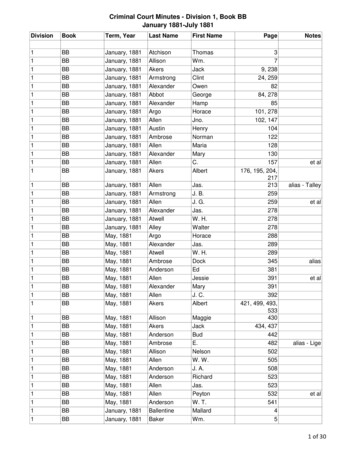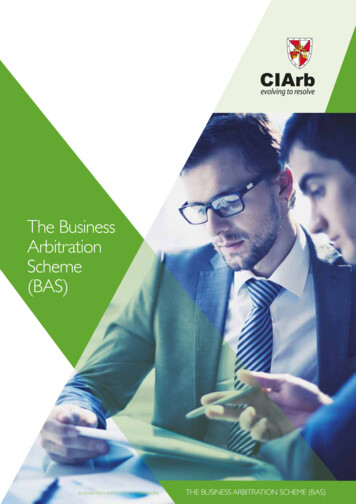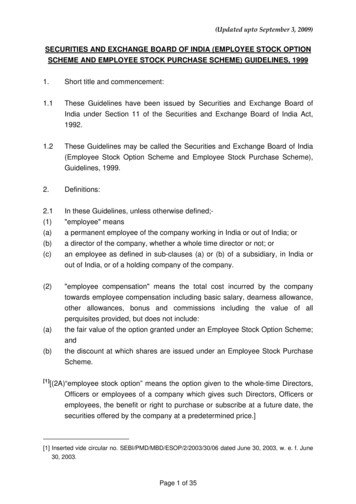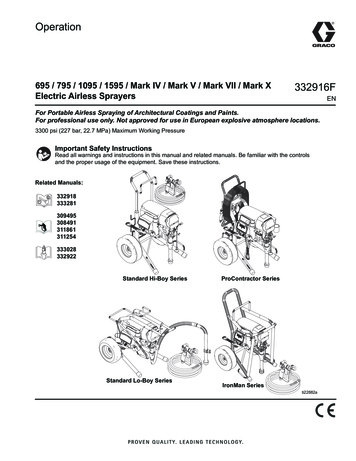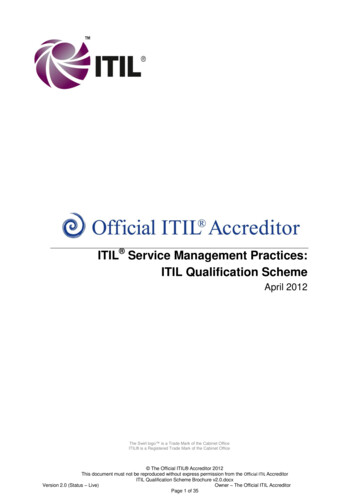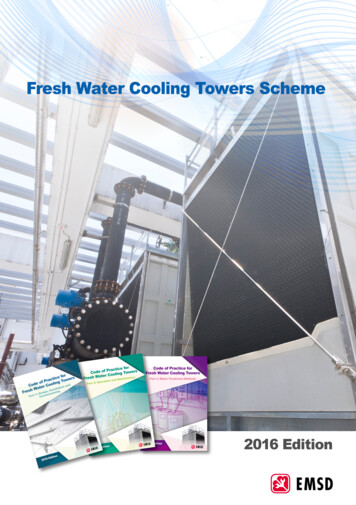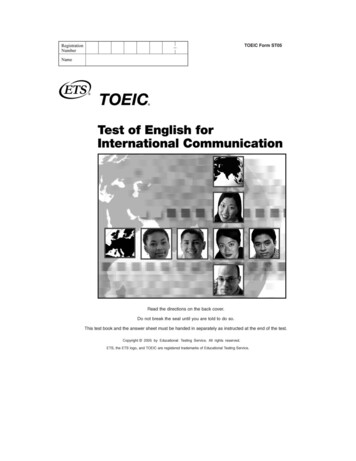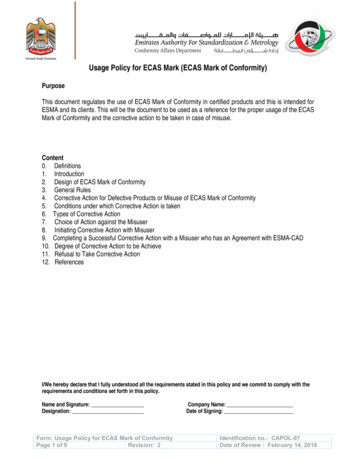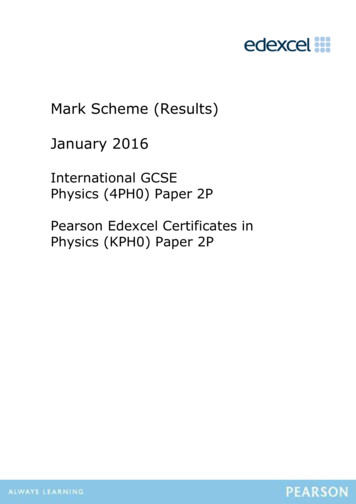
Transcription
Mark Scheme (Results)January 2016International GCSEPhysics (4PH0) Paper 2PPearson Edexcel Certificates inPhysics (KPH0) Paper 2P
Ede x ce l a n d BTEC Qu a lifica t ion sEdexcel and BTEC qualifications come from Pearson, the world’s leading learningcompany. We provide a wide range of qualifications including academic,vocational, occupational and specific programmes for employers. For furtherinformation, please visit our website at www.edexcel.com.Our website subject pages hold useful resources, support material and live feedsfrom our subject advisors giving you access to a portal of information. If youhave any subject specific questions about this specification that require the helpof a subject specialist, you may find our Ask The Expert email service helpful.www.edexcel.com/contactusPe a r son : h e lpin g pe ople pr ogr e ss, e ve r yw h e r eOur aim is to help everyone progress in their lives through education. We believein every kind of learning, for all kinds of people, wherever they are in the world.We’ve been involved in education for over 150 years, and by working across 70countries, in 100 languages, we have built an international reputation for ourcommitment to high standards and raising achievement through innovation ineducation. Find out more about how we can help you and your students at:www.pearson.com/ukJanuary 2016Publications Code UG043304All the material in this publication is copyright Pearson Education Ltd 2016
Ge n e r a l M a r k ing Gu ida n ce All candidates must receive the same treatment. Examiners mustmark the first candidate in exactly the same way as they mark thelast. Mark schemes should be applied positively. Candidates must berewarded for what they have shown they can do rather thanpenalised for omissions. Examiners should mark according to the mark scheme not accordingto their perception of where the grade boundaries may lie. There is no ceiling on achievement. All marks on the mark schemeshould be used appropriately. All the marks on the mark scheme are designed to be awarded.Examiners should always award full marks if deserved, i.e. if theanswer matches the mark scheme. Examiners should also beprepared to award zero marks if the candidate’s response is notworthy of credit according to the mark scheme. Where some judgement is required, mark schemes will provide theprinciples by which marks will be awarded and exemplification maybe limited. When examiners are in doubt regarding the application of the markscheme to a candidate’s response, the team leader must beconsulted. Crossed out work should be marked UNLESS the candidate hasreplaced it with an alternative response.
Qu e st ionn u m be r1 (a)An sw e rN ot e sMarksB – force;1(b)B – energy;1(c)A - gravitational potential energy;1(d)D – the vertical forces on it are balanced;1Tot a l 4 m a r k s
Qu e st ionn u m be r2 (a)(b)An sw e rN ot e sMarks410 000;N;allow 9800, 9810, 10allow “newton(s)”marks areindependent2(i)density mass / volume;allow abbreviation,e.g. ρ m/V, d m/Vor rearrangements1(ii)substitution OR rearrangement;award if either seen inworking2evaluation;e.g. 2300 1000/volume 0.43 (m3)(c)(i)bar chart / bar graph;(ii)any 1 from:MP1. idea that (density) data isdiscontinuous;MP2. materials have non-numericalvalues / are not quantifiable;MP3. material types identified ascategories;MP4. idea that a line graph wouldindicate continuity;(iii)cork is less denseORwater is denser;cork 25%, ¼ as denseORwater four times denser;allow 0.4, 0.434,0.435, 0.4347.condone 0.44condone histogram11discrete, categoric,non/not continuous2accept correctcalculation of bothdensities for 2 marksTot a l 9 m a r k s
Qu e st ionn u m be r3 (a)(b)An sw e rany one line correct for one mark;all three lines correct for two marks;;(i)18;192;(ii)decreases / OWTTE;(iii) remains constant / no change / nothing;N ot e sMarks2more than oneline to a boxdoes not score2ignore“molecules slowdown”11Tot a l 6 m a r k s
Qu e st ionn u m be r4 (a) (i)(ii)An sw e rN ot e sMarksMP1. (due to) friction (between car andground/air);allow idea of materialsrubbingMP2. idea of electron transfer;allow ‘scraped off’ fortransferignore “charge”, “static”reject (for MP2 mark)protons moving /positive electronsidea of an insulator OR insulatingmaterial (between car and ground);e.g. rubber tyreallow RA e.g. ‘tyre is anon-conductor’21ignore commentsrelating to charge beingunable to move e.g. ‘carnot earthed’(b)(i)(otherwise there would be a risk of)shock / spark / fire / explosion;ignore “to avoid travelsickness”12(ii)any 2 from:MP1. metal (strap) is a conductor;MP2. (hence) idea of current / chargemoving (in the strap/metal/wire);reject references topositive charge/protonsMP3. (electrons flow) betweenearth/ground/road and car;allow ideas of “earthing”or “grounding”e.g. “It (charge/car) isearthed by the strap”Tot a l 6 m a r k s
Qu e st ionn u m be r5 (a)(b)An sw e rMarksidea that higher frequency gives higherpitch;allow reverseargumentcondone idea ofproportionality /linearity1(i)(wave) speed frequency wavelengthallow abbreviation,e.g.v f λ orrearrangements1(ii)substitution into correctly rearrangedequation;evaluation;e.g.(v ) 340 / 160(v ) 2.1 (m)(c)N ot e s(i)straight line of best fit drawn withinindicated area;(ii)line of best fit extended to 20 C;student’s own value from graph halfa square;2allow 2.125, 2.12,2.13or 2 (if supported)line does not need tobe extended beyonddata range for thismark12
(d)any 2 from:MP1. speed (of sound) decreases (withtemperature);2allow ‘sound slowsdown’ignore references toparticle speedMP2. frequency is constant;MP3. so wavelength decreases (withtemperature);allow λ is smallerTot a l 9 m a r k s
Qu e st ionn u m be r6 (a)(b)An sw e rtime taken;ORfor (radio)activity to halve(i)Marksidea that background activity should besubtracted (from each reading);and eitherfor amount of (radioactive) nuclei / atoms/ isotope to halve;(c)N ot e sevidence of use of graph;1allow “how long ittakes”2allow decay by half decay to halfignore particles /molecules,“breakdown”,“reactivity”reject if implies asingle nucleus/atome.g. lines to twocorrect points ongraph or appropriatesubtraction shown inworking2any 1 from:MP1. idea of {more accurate / smoother}curve;allowmore points to plot ongraph1MP2. idea that activity changes quickly;decays quicklyMP3. idea that decay takes very little time;(sample has) shorthalf life56 3 (s);(ii)Tot a l 6 m a r k s
Qu e st ionn u m be r7 (a)An sw e rMP1. at least one straight, vertical centralfield line;MP2. any field line drawn circling the wire /at least one peripheral field loop;MP3. field directions correct and consistentthroughout and shown on at leasttwo lines;(b)any 3 from:MP1. idea of magnetic fields interacting;MP2. idea of (magnetic) attraction orrepulsion;N ot e sMarksignore breaking offield lines as theypass through thecentre of the coilby eye3condone spiraldrawn round wireallowfield lines crossingignore ‘cutting’reject mention ofelectrostatic force orcharge3MP3. reversing current reverses directionof magnetic field / force;MP4. some comparison with magnets, e.g.like poles repel, unlike poles attract;mention of having‘poles’Tot a l 6 m a r k s
Qu e st ionn u m be r8 (a)(i)An sw e rN ot e sMarks385 (J);(ii)1reverse calculation e.g.calculating a voltage orcharge gains 1 markmax.substitution into E QV;evaluation to at least 2 s.f.;2if no other mark givenallow 1 mark for 106 or1000000 seen inworkinge.g.(E ) 385 180 000(E ) 69 000 000 (J) / 69 (MJ)(iii)MP1. idea of energy wasted;MP2. appropriate mechanism;8(b)allow ecf from 8(a)(i)valueallow not 100%efficient, energy loste.g. heat in wires2(i)charge current time;allow abbreviations e.g.Q I tor uation;ignore not convertingtime to seconds untilevaluation3e.g.180 000 current x (110 x 60)(current ) 180 000 / (110 60)(current ) 27 (A)allow 27.3, 27.27 1600, 1640, 1636 etc.gain 2 marksif no other mark givenallow 1 mark for 60seen anywhere inworking (attempt toconvert to seconds)Tot a l 9 m a r k s
Qu e st ionn u m be r9An sw e rany 5 from:MP1. increased voltage (with step uptransformer);N ot e sMarks5allow ‘steps upvoltage’MP2. (therefore) reduced current;MP3. current linked to heating;MP4. (therefore) less {energy /power} is lost / wasted (intransmission);MP5. reference to P I2R equation;MP6. example of an efficiencyenhancing detail of cables;MP7. example of an efficiencyenhancing detail of transformerconstruction;MP8. step down transformer reducesvoltage / increases current;allow P IV if clearthat V is the voltagedrop across thecables.e.g. good conductor,low resistance, largediametere.g. low resistancecoils, coils wrappedon top of each other,soft iron core,laminated coreallow ‘steps downvoltage’Tot a l 5 m a r k s
Pearson Education Limited. Registered company number 872828with its registered office at 80 Strand, London WC2R 0RL
(ii) idea of an insulator OR insulating material (between car and ground); e.g. rubber tyre allow RA e.g. 'tyre is a non-conductor' ignore comments relating to charge being unable to move e.g. 'car not earthed' 1 (b) (i) (otherwise there would be a risk of) shock / spark / fire / explosion; ignore "to avoid travel sickness" 1 2
